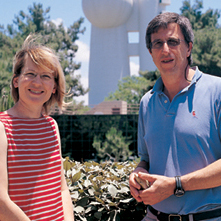Are you a journalist? Please sign up here for our press releases
Subscribe to our monthly newsletter:

While our distant ancestors did not use a knife and fork the way we do, they had flint - a hard rock used to create tools for hunting, cooking and building. But making these tools, it turns out, was far from easy. Flint tends to crack and wither when exposed to atmospheric weathering. While know-how for producing flint existed already 2.5 million years ago, only with time did our ancestors learn how to obtain durable production materials: their secret was to dig - obtaining flint from mines rather than surface deposits - and their idea proved to be a pivotal technological advance, with important intellectual and cultural fringe benefits.
Dr. Elisabetta Boaretto of the Environmental Sciences and Energy Research Department recently traced this cultural transition.
Working with Prof. Steve Weiner, head of the Helen and Martin Kimmel Center for Archaeological Sciences, and with Prof. Micha Hass of the Particle Physics Department, Boaretto used a nuclear physics technique to determine whether flint samples from the prehistoric caves of Tabun (in the Carmel) and Qesem (near Rosh Ha’ayen) were produced from surface or underground deposits.
“When the flint (silicon dioxide) is exposed on Earth’s surface, it produces beryllium 10 through an interaction between cosmic rays and the oxygen in the silica mineral,” explains Boaretto. “If the same material is buried about two meters below the surface, this effect is reduced to a negligible level. Our assumption was that tool samples made of flint collected from surface deposits would have measurably higher Be10 levels than those derived from mined flint.”
Using the Institute’s Koffler pelletron accelerator to measure beryllium 10 concentrations, Boaretto and her colleagues found that flint samples collected from one layer of the Tabun Cave deposited about 350,000 years ago had beryllium 10 levels similar to mined material. In contrast, those found in the Qesem Cave, from about the same period, had a beryllium 10 distribution consistent with flint gathered from above ground or from shallow quarries. Were the people of Tabun pickier - i.e. more advanced - in choosing the raw material for their flint tools than their neighbors in Qesem? The data suggest so, but more research is needed.
Other scientists collaborating in this research are: Prof. Michael Paul and postdoctoral fellow Dr. Giovanni Verri of the Hebrew University and Prof. Avi Gopher and Dr. Ran Barkay of Tel Aviv University.
Elisabetta Boaretto came to Israel from Padua, Italy, for her Ph.D. in physics at the Hebrew University with Prof. Michael Paul. As part of her experimental work, she used the Koffler pelletron accelerator at the WIS (which is where she met her Israeli-born husband, Dror Kella, also a physicist) to measure rare radioisotopes from ice cores in Greenland and Antarctica. The couple later pursued postdoctoral studies at Aarhus University in Denmark. They have two children, Eyal and Iris.
Prof. Weiner’s research is supported by the Helen and Martin Kimmel Center for Archaeological Sciences; the Women’s Health Research Center; the Philip M. Klutznick Fund; the Alfried Krupp von Bohlen und Halbach Foundation and Mr. George Schwartzman, Sarasota, FL. He is the incumbent of the Dr. Walter and Dr. Trude Borchardt Professorial Chair in Structural Biology.